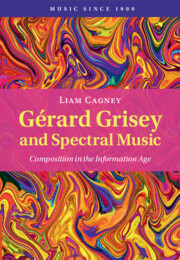Refine search
Actions for selected content:
28 results
Chapter 14 - Pierre Boulez and John Cage
- from Part III - Engagements with the Post-War Generation of Composers
-
-
- Book:
- Boulez in Context
- Published online:
- 08 July 2025
- Print publication:
- 24 July 2025, pp 137-151
-
- Chapter
- Export citation
Chapter 17 - The Articulatory Function of Space
- from Part III - Engagements with the Post-War Generation of Composers
-
-
- Book:
- Boulez in Context
- Published online:
- 08 July 2025
- Print publication:
- 24 July 2025, pp 174-185
-
- Chapter
- Export citation
Chapter 20 - Boulez’s Poets
- from Part IV - Creative Engagements beyond Music
-
-
- Book:
- Boulez in Context
- Published online:
- 08 July 2025
- Print publication:
- 24 July 2025, pp 215-226
-
- Chapter
- Export citation
Chapter 8 - Boulez and Stravinsky
- from Part II - Musical Modernism
-
-
- Book:
- Boulez in Context
- Published online:
- 08 July 2025
- Print publication:
- 24 July 2025, pp 76-83
-
- Chapter
- Export citation
Chapter 9 - Boulez and the Second Viennese Composers
- from Part II - Musical Modernism
-
-
- Book:
- Boulez in Context
- Published online:
- 08 July 2025
- Print publication:
- 24 July 2025, pp 84-92
-
- Chapter
- Export citation
Chapter 35 - Remembering Pierre
- from Part VII - Legacy
-
-
- Book:
- Boulez in Context
- Published online:
- 08 July 2025
- Print publication:
- 24 July 2025, pp 363-369
-
- Chapter
- Export citation
4 - Akin Euba
- from Part II - Two Case Studies
-
- Book:
- Musical Modernism in Global Perspective
- Published online:
- 23 May 2024
- Print publication:
- 30 May 2024, pp 153-177
-
- Chapter
- Export citation
Part III - Styles, Conventions, and Issues
-
- Book:
- The Cambridge Companion to Composition
- Published online:
- 25 May 2024
- Print publication:
- 30 May 2024, pp 175-284
-
- Chapter
- Export citation
2 - Messiaen’s Class and New Music in Late 1960s Paris (1967–1970)
- from Part I - Grisey’s Style
-
- Book:
- Gérard Grisey and Spectral Music
- Published online:
- 30 November 2023
- Print publication:
- 14 December 2023, pp 34-68
-
- Chapter
- Export citation
6 - L’Itinéraire and Synthetic Music (1973–1976)
- from Part II - Spectral Music
-
- Book:
- Gérard Grisey and Spectral Music
- Published online:
- 30 November 2023
- Print publication:
- 14 December 2023, pp 157-196
-
- Chapter
- Export citation
Conclusion
-
- Book:
- Gérard Grisey and Spectral Music
- Published online:
- 30 November 2023
- Print publication:
- 14 December 2023, pp 261-269
-
- Chapter
- Export citation
7 - New Dimensions (1976–1978)
- from Part II - Spectral Music
-
- Book:
- Gérard Grisey and Spectral Music
- Published online:
- 30 November 2023
- Print publication:
- 14 December 2023, pp 197-233
-
- Chapter
- Export citation
3 - Statistical Serialism and Vagues, chemins, le souffle (1970–1972)
- from Part I - Grisey’s Style
-
- Book:
- Gérard Grisey and Spectral Music
- Published online:
- 30 November 2023
- Print publication:
- 14 December 2023, pp 69-94
-
- Chapter
- Export citation
Introduction
-
- Book:
- Gérard Grisey and Spectral Music
- Published online:
- 30 November 2023
- Print publication:
- 14 December 2023, pp 1-10
-
- Chapter
- Export citation
8 - Spectral Music and écriture liminale (1979–1982)
- from Part II - Spectral Music
-
- Book:
- Gérard Grisey and Spectral Music
- Published online:
- 30 November 2023
- Print publication:
- 14 December 2023, pp 234-260
-
- Chapter
- Export citation

Gérard Grisey and Spectral Music
- Composition in the Information Age
-
- Published online:
- 30 November 2023
- Print publication:
- 14 December 2023
4 - Cognitive Science
- from II - The Never-Ending Debate
-
- Book:
- A Mind for Language
- Published online:
- 13 October 2023
- Print publication:
- 21 September 2023, pp 89-129
-
- Chapter
- Export citation
3 - Serialism in History and Criticism
- from Part I - Contexts I
-
-
- Book:
- The Cambridge Companion to Serialism
- Published online:
- 07 March 2023
- Print publication:
- 16 February 2023, pp 37-54
-
- Chapter
- Export citation
13 - Serialism in Canada and the United States
- from Part III - Geographies
-
-
- Book:
- The Cambridge Companion to Serialism
- Published online:
- 07 March 2023
- Print publication:
- 16 February 2023, pp 225-240
-
- Chapter
- Export citation
6 - Rethinking Late Webern
- from Part II - Composers
-
-
- Book:
- The Cambridge Companion to Serialism
- Published online:
- 07 March 2023
- Print publication:
- 16 February 2023, pp 87-107
-
- Chapter
- Export citation
